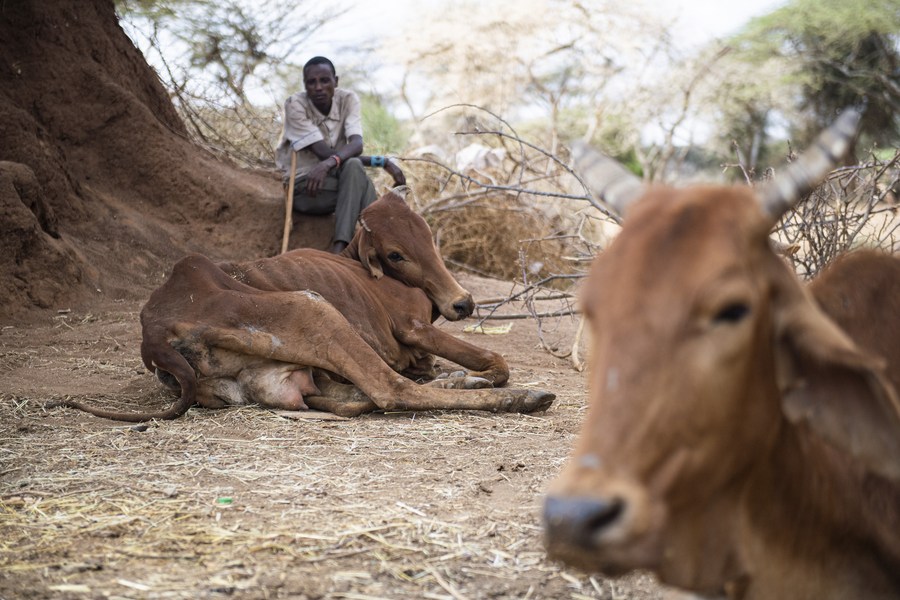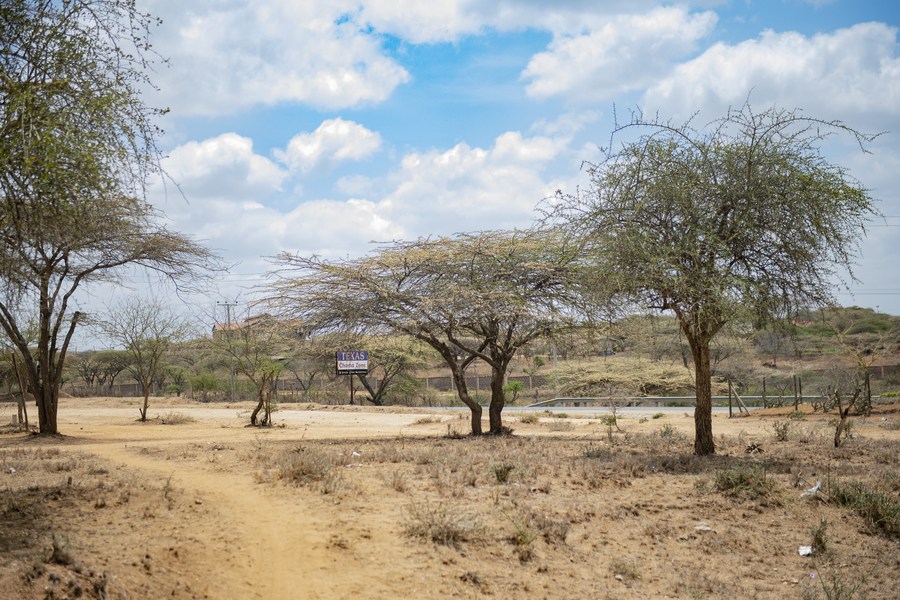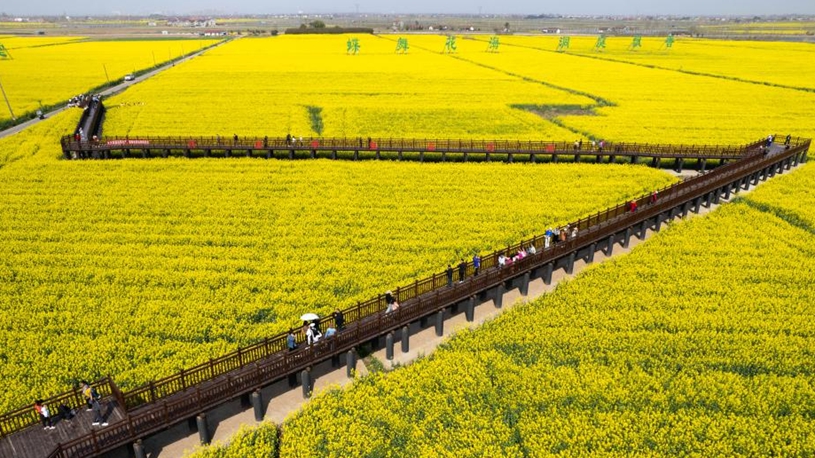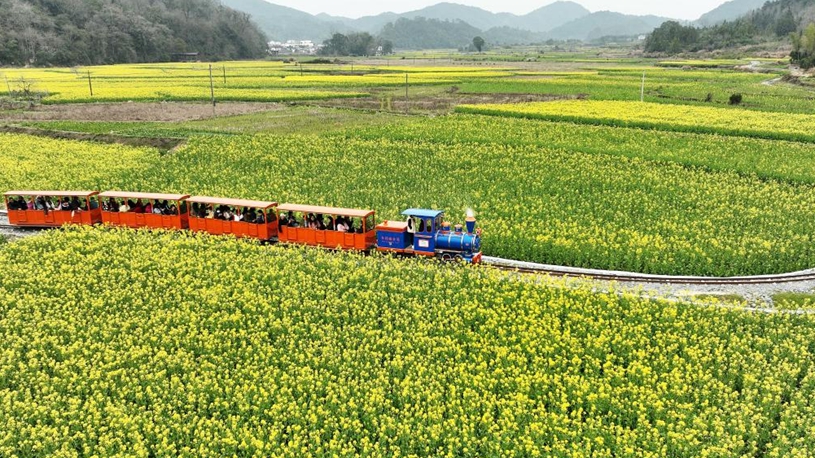
This photo taken on Feb. 28, 2023 shows a Maasai trader gazing at emaciated livestock at a livestock market in Kajiado County, Kenya. (Xinhua/Li Yahui)
In an expansive livestock market nestled in a small town in southern Kenya, a group of elderly herders tightly clutch onto the ropes tethering their animals. The small-bodied livestock stand listless under the hot sun with their bones pressing through skins.
NAIROBI, March 16 (Xinhua) -- In an expansive livestock market nestled in a small town in southern Kenya, a group of elderly herders tightly clutch onto the ropes tethering their animals. The small-bodied livestock stand listless under the hot sun with their bones pressing through skins.
"Livestock market has been badly affected by the drought; a female small-bodied cow fetches 10,000 (Kenyan) shillings (about 77 U.S. dollars) while a male cow will cost 192.61 dollars. The prices have dropped threefold since last year, and they continue dropping," John Ngao, chairman of Tala livestock market, told Xinhua in a recent interview.
Ngao said since the establishment of the market decades ago, the traders have never experienced a drought of such magnitude. Tala Town, located in the southern Kenyan county of Machakos, is sandwiched between sunbaked plains, with the primary source of livelihood being agriculture and livestock keeping.
This photo taken on Feb. 28, 2023 shows wilted vegetation in Kajiado County, Kenya. (Xinhua/Li Yahui)
Kenya and its neighbors in the Horn of Africa region are experiencing a debilitating drought situation that has severely impacted people, crops, and biodiversity. The livestock supply chain, which includes players such as animal traders, abattoirs, animal feed suppliers, and meat sellers, has been severely affected. Among the undesirable outcomes are high animal mortality, diminished vegetation, and low market prices.
The drought has rendered an estimated 6 million people in 32 counties food insecure, according to the National Drought Management Authority's (NDMA) latest report. In addition, at least 2.6 million livestock have died as a result of the ongoing drought translating to a loss of 1.8 billion dollars.
"The prolonged drought has limited access to water. More than 60 percent of open water sources have dried up, while river flows are below 40 percent of normal. There is frequent breakdown of boreholes due to increased demand," said Rebecca Miano, cabinet secretary in the Ministry of East African Community, Arid and Semi-Arid Lands and Regional Development.
Dorcas Muia, a resident of Machakos County, had 10 cows in early 2022, but at present, she has only two cows remaining.
"My children are frequently sent home because I am unable to pay school fees on time," Muia told Xinhua during a recent interview. Muia's work involves buying livestock and fattening them before disposing of them at a profitable rate.
Since the drought began some four years ago, Muia's livestock began losing weight rapidly as she could not buy adequate animal feed and water. To pivot, she disposed of the animals at a throw-away price retaining only two calves.
"People have changed the breeds they were keeping from Friesian to a drought-tolerant breed like Zebu, which will be able to go for three days with very little water," said Muia.
Lilian Ngondu stood perturbed under the hot sun as she watched her goats scratch the bare ground for something to eat.
"The animals are falling sick because of feeding on poisonous weeds; they are also eating a lot of polythene and other unsafe materials because they are hungry," Ngondu said. The mother of three now has to sell goats for a mere 30.77 dollars from upwards of 230.79 dollars which they fetched last year.
This photo taken on Feb. 28, 2023 shows horns of livestock after their corpses were cremated near a livestock market in Kajiado County, Kenya. (Xinhua/Li Yahui)
For butchery operator Paul Okello, the cost of drought has precipitated a shortage of all kinds of meat.
Okello operates from Burma Market, one of the largest meat distributors in the Kenyan capital of Nairobi. The market receives tons of meat supplies from abattoirs spread across the country. "The meat supply is generally strained because of reduced meat coming into the market," said Okello.
A kilogram of beef meat is now retailing at 4.23 dollars, an increase of 0.76 dollars from last year. "The customers keep complaining about the price, but if we do not transfer the expense, we shall be taking a big loss," he added.
Okello added that with the drought, he is motivated to buy mutton from abattoirs instead of beef, which will not fetch him enough money.
The 2022 October-December rainfall posted poor downpours, which marked the fifth consecutive failed rain season in Kenya, according to official reports.
The Kenya Meteorological Department, in its March-May rainfall outlook, predicts below-average rainfall in most parts of the country, a situation that is likely to upend livelihoods for people like Okello. ■












